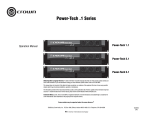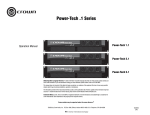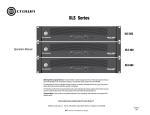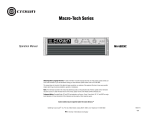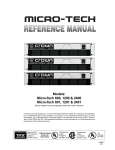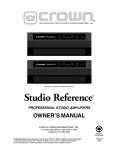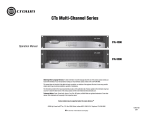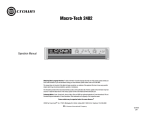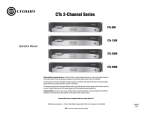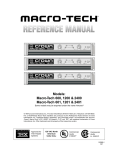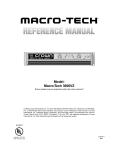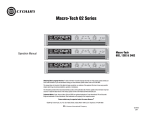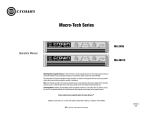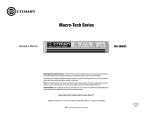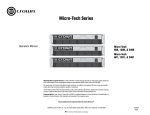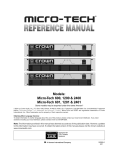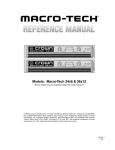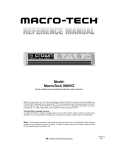Download Crown STUDIO AMPLIFIER Specifications
Transcript
Studio Reference Series ® Studio Reference I Operation Manual ® Studio Reference II Obtaining Other Language Versions: To obtain information in another language about the use of this product, please contact your local Crown Distributor. If you need assistance locating your local distributor, please contact Crown at 574-294-8000. This manual does not include all of the details of design, production, or variations of the equipment. Nor does it cover every possible situation which may arise during installation, operation or maintenance. The information provided in this manual was deemed accurate as of the publication date. However, updates to this information may have occurred. To obtain the latest version of this manual, please visit the Crown website at www.crownaudio.com. Trademark Notice: Studio Reference, SmartAmp, Grounded Bridge, PIP2 and PIP are trademarks and Crown, Amcron, IOC, ODEP, and IQ are registered trademarks of Crown International. Other trademarks are the property of their respective owners. Some models may be exported under the name Amcron.® ©2003 by Crown Audio Inc., P.O. Box 1000, Elkhart, Indiana 46515-1000 U.S.A. Telephone: 574-294-8000 132176-3 5/03 Studio Reference I & II Professional Studio Amplifiers Important Safety Instructions 1) 2) 3) 4) 5) 6) 7) 8) 9) 10) 11) 12) 13) 14) 15) page 2 Read these instructions. Keep these instructions. Heed all warnings. Follow all instructions. Do not use this apparatus near water. Clean only with a dry cloth. Do not block any ventilation openings. Install in accordance with the manufacturer’s instructions. Do not install near any heat sources such as radiators, heat registers, stoves, or other apparatus that produce heat. Do not defeat the safety purpose of the polarized or grounding-type plug. A polarized plug has two blades with one wider than the other. A grounding-type plug has two blades and a third grounding prong. The wide blade or the third prong is provided for your safety. If the provided plug does not fit into your outlet, consult an electrician for replacement of the obsolete outlet. Protect the power cord from being walked on or pinched, particularly at plugs, convenience receptacles, and the point where they exit from the apparatus. Only use attachments/accessories specified by the manufacturer. Use only with a cart, stand, bracket, or table specified by the manufacturer, or sold with the apparatus. When a cart is used, use caution when moving the cart/apparatus combination to avoid injury from tip-over. Unplug this apparatus during lightning storms or when unused for long periods of time. Refer all servicing to qualified service personnel. Servicing is required when the apparatus has been damaged in any way, such as powersupply cord or plug is damaged, liquid has been spilled or objects have fallen into the apparatus, the apparatus has been exposed to rain or moisture, does not operate normally, or has been dropped. To reduce the risk of fire or electric shock, do not expose this apparatus to rain or moisture. TO PREVENT ELECTRIC SHOCK DO NOT REMOVE TOP OR BOTTOM COVERS. NO USER SERVICEABLE PARTS INSIDE. REFER SERVICING TO QUALIFIED SERVICE PERSONNEL. À PRÉVENIR LE CHOC ÉLECTRIQUE N’ENLEVEZ PAS LES COUVERCLES. IL N’Y A PAS DES PARTIES SERVICEABLE À L’INTÉRIEUR. TOUS REPARATIONS DOIT ETRE FAIRE PAR PERSONNEL QUALIFIÉ SEULMENT. IMPORTANT Studio Reference Series amplifiers require Class 2 output wiring. MAGNETIC FIELD CAUTION! Do not locate sensitive high-gain equipment such as preamplifiers or tape decks directly above or below the unit. Because this amplifier has a high power density, it has a strong magnetic field which can induce hum into unshielded devices that are located nearby. The field is strongest just above and below the unit. If an equipment rack is used, we recommend locating the amplifier(s) in the bottom of the rack and the preamplifier or other sensitive equipment at the top. WATCH FOR THESE SYMBOLS: FCC COMPLIANCE NOTICE This device complies with part 15 of the FCC rules. Operation is subject to the following two conditions: (1) This device may not cause harmful interference, and (2) this device must accept any interference received, including interference that may cause undesired operation. CAUTION: Changes or modifications not expressly approved by the party responsible for compliance could void the user’s authority to operate the equipment. NOTE: This equipment has been tested and found to comply with the limits for a Class B digital device, pursuant to part 15 of the FCC Rules. These limits are designed to provide reasonable protection against harmful interference in a residential installation. This equipment generates, uses, and can radiate radio frequency energy and, if not installed and used in accordance with the operation manual, may cause harmful interference to radio communications. However, there is no guarantee that interference will not occur in a particular installation. If this equipment does cause harmful interference to radio or television reception, which can be determined by turning the equipment off and on, the user is encouraged to try to correct the interference by one or more of the following measures: • Reorient or relocate the receiving antenna. • Increase the separation between the equipment and receiver. • Connect the equipment into an outlet on a circuit different from that to which the receiver is connected. • Consult the dealer or an experienced radio/TV technician for help. The lightning bolt triangle is used to alert the user to the risk of electric shock. The exclamation point triangle is used to alert the user to important operating or maintenance instructions. Operation Manual Studio Reference I & II Professional Studio Amplifiers DECLARATION of CONFORMITY Crown International, Inc. Issued By: Crown International, Inc. 1718 W. Mishawaka Road Elkhart, Indiana 46517 U.S.A. Sue Whitfield 574-294-8289 [email protected] European Representative's Name and Address: Nick Owen 19 Clos Nant Coslech Pontprennau Cardiff CF23 8ND United Kingdom Equipment Type: Commercial Audio Power Amplifiers Family Name: Studio Reference Model Names: Studio Reference I, Studio Reference II EMC Standards: EN 55103-1:1995 Electromagnetic Compatibility - Product Family Standard for Audio, Video, Audio-Visual and Entertainment Lighting Control Apparatus for Professional Use, Part 1: Emissions EN 55103-1:1995 Magnetic Field Emissions-Annex A @ 10 cm and 1 M EN 61000-3-2:1995+A14:2000 Limits for Harmonic Current Emissions (equipment input current ≤16A per phase) EN 61000-3-3:1995 Limitation of Voltage Fluctuations and Flicker in Low-Voltage Supply Systems Rated Current ≤16A EN 55022:1992 + A1: 1995 & A2:1997 Limits and Methods of Measurement of Radio Disturbance Characteristics of ITE: Radiated, Class B Limits; Conducted, Class B EN 55103-2:1996 Electromagnetic Compatibility - Product Family Standard for Audio, Video, Audio-Visual and Entertainment Lighting Control Apparatus for Professional Use, Part 2: Immunity EN 61000-4-2:1995 Electrostatic Discharge Immunity (Environment E2-Criteria B, 4k V Contact, 8k V Air Discharge) EN 61000-4-3:1996 Radiated, Radio-Frequency, Electromagnetic Immunity (Environment E2, criteria A) EN 61000-4-4:1995 Electrical Fast Transient/Burst Immunity (Criteria B) EN 61000-4-5:1995 Surge Immunity (Criteria B) EN 61000-4-6:1996 Immunity to Conducted Disturbances Induced by Radio-Frequency Fields (Criteria A) EN 61000-4-11:1994 Voltage Dips, Short Interruptions and Voltage Variation Safety Standard: EN 60065: 1998 Safety Requirements - Audio Video and Similar Electronic Apparatus I certify that the product identified above conforms to the requirements of the EMC Council Directive 89/336/EEC as amended by 92/31/EEC, and the Low Voltage Directive 73/23/EES as amended by 93/68/EEC. Signed Larry Coburn Title: Senior Vice President of Manufacturing Operation Manual Date of Issue: January 1, 2000 DUE TO LINE CURRENT HARMONICS, WE RECOMMEND THAT YOU CONTACT YOUR SUPPLY AUTHORITY BEFORE CONNECTION. page 3 Studio Reference I & II Professional Studio Amplifiers Table of Contents page 4 Important Safety Instructions .......................................................2 4.2.4 Circuit Breaker ....................................................... 19 Declaration of Conformity ............................................................3 4.3 Filter Cleaning ................................................................ 19 1 Welcome .................................................... 5 4.4 Controls ......................................................................... 20 1.1 Features ...........................................................................5 4.4.1 Level Controls ....................................................... 20 1.2 How to Use This Manual ..................................................6 4.4.2 Meter Switches ...................................................... 20 2 Setup ......................................................... 7 4.4.3 Ground Lift Switch ................................................. 21 2.1 Unpack Your Amplifier ....................................................7 4.4.4 Input Sensitivity Switch ......................................... 21 2.2 Install Your Amplifier ......................................................7 4.5 PIP Modules ................................................................... 21 2.3 Ensure Proper Cooling ...................................................7 5 Principles of Operation ....................................22 2.4 Choose Input Wire and Connectors ................................8 5.1 Overview ........................................................................ 22 2.5 Choose Output Wire and Connectors ..............................8 5.2 Circuit Theory ................................................................ 23 2.6 Wire Your System ...........................................................9 5.2.1 Stereo Operation .................................................... 23 2.6.1 Stereo Mode ..........................................................9 5.2.2 Bridge-Mono Operation ......................................... 23 2.6.2 Bridge-Mono Mode ...............................................10 5.2.3 Parallel-Mono Operation ....................................... 23 2.6.3 Parallel-Mono Mode...............................................11 6 Troubleshooting ............................................24 2.7 Connect to AC Mains ......................................................12 7 Specifications ..............................................25 2.8 Startup Procedure ...........................................................12 7.1 Mininum Guaranteed Power Specifications .................... 27 3 Operation ...................................................13 7.2 Maximum Power Specifications ..................................... 29 3.1 Precautions ..................................................................... 13 8. AC Power Draw & Thermal Dissipation ................32 3.2 Front Panel Controls and Indicators ............................... 15 9 Service ... .............................................................................. 34 3.3 Back Panel Controls and Connectors............................... 17 9.1 Worldwide Service .......................................................... 34 4 Advanced Features and Options .........................18 9.2 US and Canada Service .................................................. 34 4.1 Indicators ....................................................................... 18 9.2.1 Service at a US or Canada Service Center ............. 34 4.2 Protection Systems ........................................................ 18 9.2.2 Factory Service ...................................................... 34 4.2.1 ODEP...................................................................... 18 9.2.3 Factory Service Shipping Instructions ................... 34 4.2.2 Standby Mode ........................................................ 19 10 Warranty ...................................................35 4.2.3 Transformer Thermal Protection ............................. 19 Crown Factory Service Information Form ...................................37 Operation Manual Studio Reference I & II Professional Studio Amplifiers ® 1 Welcome The stunning realism you will experience when listening to a Crown® Studio Reference™ amplifier will redefine your expectations. The evolution of this studio standard ushers in a new era of powerful, ultraquiet amplifiers capable of faithfully reproducing the most demanding of signals. This kind of sonic integrity does not happen accidentally. It demands the leadership and technical excellence for which Crown has long been known. With the best transfer function in the industry, ultra-high dynamic range and extraordinary damping factor, your Studio Reference amplifier comes closer to the ideal “straight wire with gain” than any other amplifier. As you listen, it will become apparent—the amplifier’s low-frequency transient response is the standard by which all others must be judged. We have taken great care at every step in the creation of your amplifier—from the selection of its components to the routing of each wire. It is our goal to provide you with total satisfaction. This is one reason why we have spent considerable effort in providing you with the most complete Reference Manual in the business. Please read it carefully—especially the instructions, warnings and cautions. It will help you successfully install and use your new amplifier. Be sure to read Sections 2.5.2 and 2.5.3 if you plan to use one of the amplifier’s two mono modes. • IOC® (Input/Output Comparator) circuitry immediately alerts you of any distortion that exceeds 0.05% to provide dynamic proof of distortion-free performance. 1.1 Features • Accurate Studio Reference amplifiers integrate several cutting edge technologies that make them the most accurate reference amplifiers available. For example, in Stereo mode each channel can actually be treated as a separate amplifier because of its separate high-voltage power supplies and ultra-low crosstalk. Here are some of its many impressive features: • Extremely wide dynamic range. • Crown’s unconventional Grounded Bridge™ circuitry delivers incredible voltage swings without using stressful output transistor configurations like other more traditional amplifiers. This results in significantly lower distortion and superior reliability. • Patented ODEP® (Output Device Emulation Protection) circuitry detects and compensates for overheating and overload to keep the amplifier working when others would fail. • PIP™ (Programmable Input Processor) connector accepts accessories that tailor your amplifier to suit specific applications. • Ultra-high damping factor delivers superior loudspeaker motion control for the cleanest, tightest bottom end you’ve ever felt—or heard. • Super-low harmonic and intermodulation distortion give your amplifier the best transfer function in the business. • Two mono modes (Bridge-Mono and ParallelMono) for driving a wide range of load impedances. • Custom-designed, tape-wound, low-noise toroidal supplies with extremely high power density. • High-voltage headroom and high-current headroom provide energy reserves that make it easy to drive low-impedance loads and highly reactive loads to full power. • Full protection against shorted outputs, mismatched loads, general overheating, DC and Operation Manual page 5 Studio Reference I & II Professional Studio Amplifiers 1 Welcome high-frequency overloads. Full overvoltage and internal fault protection. • Indicators include Enable, ODEP, IOC, Signal Presence and the Dynamic Range/Level meter. • Balanced phone jacks and XLR connectors are provided for input. Two pair of 5-way binding posts per channel are provided for versatile output connection. • Ground lift switch isolates the AC power and phone jack audio grounds. • Efficient heat sinks and a self-contained, ondemand, infinitely variable forced-air cooling system prevents overheating and prolongs component life. • Internal three-position input sensitivity switch provides settings of 0.775 volts and 1.4 volts for standard 1 kHz power, and 26 dB gain. 1.2 How to Use This Manual This manual provides you with the necessary information to safely and correctly setup and operate your amplifier. It does not cover every aspect of installation, setup or operation that might occur under every condition. For additional information, please consult Crown’s Amplifier Application Guide (available online at www.crownaudio.com), Crown Technical Support, your system installer or retailer. We strongly recommend you read all instructions, warnings and cautions contained in this manual. Also, for your protection, please send in your warranty registration card today. And save your bill of sale — it’s your official proof of purchase. • Mounts in a standard 19 inch (48.3 cm) equipment rack, or units can be stacked directly on top of each other. • Three year “No-Fault” full warranty completely protects your investment and guarantees its specifications. page 6 Operation Manual Studio Reference I & II Professional Studio Amplifiers 2 Setup 2.1 Unpack Your Amplifier Please unpack and inspect your amplifier for any damage that may have occurred during transit. If damage is found, notify the transportation company immediately. Only you can initiate a claim for shipping damage. Crown will be happy to help as needed. Save the shipping carton as evidence of damage for the shipper’s inspection. We also recommend that you save all packing materials so you will have them if you ever need to transport the unit. Never ship the unit without the factory pack. YOU WILL NEED (not supplied): • Input wiring cables • Output wiring cables 2.3 Ensure Proper Cooling When using an equipment rack, mount units directly on top of each other. Close any open spaces in rack with blank panels. DO NOT block front, rear or side air vents. The side walls of the rack should be a minimum of two inches (5.1 cm) away from the amplifier sides, and the back of the rack should be a minimum of four inches (10.2 cm) from the amplifier back panel. 2.2 Install Your Amplifier CAUTION: Before you begin, make sure your amplifier is disconnected from the power source, with the power switch in the “off” position and all level controls turned completely down (counterclockwise). Use a standard 19-inch (48.3 cm) equipment rack (EIA RS-310B). See Figure 2.2 for amplifier dimensions. Figure 2.3 illustrates standard amplifier airflow. You may also stack amps without using a cabinet. NOTE: When transporting, amplifiers should be supported at both front and back. Rack for mounting amplifier (or a stable surface for stacking) WARNING: Before you start to set up your amplifier, make sure you read and observe the Important Safety Instructions found at the beginning of this manual. Before proceeding, make sure the meter switches are set to your liking. The front panel assembly must first be removed to changed these switches, so it is easier to do before the unit is mounted (see Section 4.4.2). The rack ears are covered by two attractive end caps which are held in place by phillips screws (see Figure 2.1). To use the rack ears, remove the screws and lift off the caps. With sufficient side clearance, you can reinstall the end caps once the amplifier is mounted in the rack. Figure 2.1 Removing an End Cap ® 7 in (17.3 cm) FRONT VIEW 19 in (48.3 cm) SIDE VIEW Figure 2.3 Airflow 16 in (40.6 cm) 1.4 in (3.6 cm) Figure 2.2 Dimensions Operation Manual page 7 Studio Reference I & II Professional Studio Amplifiers 2 Setup 2.4 Choose Input Wire and Connectors Crown recommends using pre-built or professionally wired, balanced line (two-conductor plus shield), 22-24 gauge cables and connectors. Use either 3-pin male XLR connectors orTRS phone plugs at the amplifier inputs. Unbalanced lines may also be used but may result in noise over long cable runs. Connector pin assignments and wiring are shown in thes Figures: Figure 2.4: Unbalanced XLR Figure 2.5: Balanced XLR Figure 2.6: Balanced and unbalanced phone plugs. NOTE: Custom wiring should only be performed by qualified personnel. Figure 2.5 Balanced Input Wiring 2.5 Choose Output Wire and Connectors Crown recommends using pre-built or professionally wired, highquality, two-conductor, heavy gauge speaker wire and connectors. You may use banana plugs, spade lugs, or bare wire for your output connectors (Figure 2.7). To prevent the possibility of shortcircuits, wrap or otherwise insulate exposed loudspeaker cable connectors. NOTE: Binding post outputs on European models come with safety plugs installed to prevent European powercord plugs from being inserted. The top & bottom entry positions for these connectors should therefore be used with European models. Figure 2.6 Balanced and Unbalanced Phone Plugs Using the guidelines below, select the appropriate size of wire based on the distance from amplifier to speaker. Distance up to 25 ft. 26-40 ft. 41-60 ft. 61-100 ft. 101-150 ft. 151-250 ft. Wire Size 16 AWG 14 AWG 12 AWG 10 AWG 8 AWG 6 AWG CAUTION: Never use shielded cable for output wiring. page 8 Figure 2.4 Unbalanced Input Wiring Figure 2.7 Output Connector Wiring Note: Each output channel has two sets of binding posts (not shown here) to make it easier to connect multiple loudspeaker cables to each channel. Operation Manual Studio Reference I & II Professional Studio Amplifiers 2 Setup 2.6 Wire Your System 2.6.1 Stereo Mode Typical input and output wiring is shown in Figure 2.8. CHANNEL 2 LOUDSPEAKER Turn off the amplifier and set the Stereo/Mono Switch to Stereo. CHANNEL 1 INPUTS: Connect input wiring for both channels. CHANNEL 2 NOTE: Crown provides a reference of wiring pin assignments for commonly used connector types in the Crown Amplifier Application Guide available at www.crownaudio.com. – + CHANNEL 1 LOUDSPEAKER + – MIXER CH-2 CH-1 FX PUSH OUTPUTS: Each output channel has two sets of binding posts to make it easier to connect multiple loudspeaker cables to each channel. PUSH Maintain proper polarity (+/–) on output connectors. Connect Channel 1 loudspeaker’s positive (+) lead to Channel 1 positive (red) terminal of amp; repeat for negative (–). Repeat Channel 2 wiring as for Channel 1. Reference S T U D I O STUDIO REFERENCE AMPLIFIER STEREO PARALLEL MONO BRIDGE MONO CAUTION: TURN OFF AMPLIFIER CAUTION: In Stereo mode, never tie an amplifier’s outputs together directly, and never parallel them with the output of another amplifier. Such connections do not result in increased output power, but may activate the protection circuitry to prevent overheating. Operation Manual BEFORE CHANGING THIS SWITCH! Figure 2.8 Stereo Wiring page 9 Studio Reference I & II Professional Studio Amplifiers 2 Setup 2.6.2 Bridge-Mono Mode Bridge-Mono mode is used to drive loads with a total impedance of 4 ohms or higher. Turn off the amplifier and set the Stereo/Mono Switch to Bridge Mono. – CHANNEL 1 Typical input and output wiring is shown in Figure 2.9. + MIXER LOUDSPEAKER DO NOT USE THE CHANNEL 2 INPUTS. INPUTS: Use only the Channel 1 input connector. CH-2 NOTE: Crown provides a reference of wiring pin assignments for commonly used connector types in the Crown Amplifier Application Guide available at www.crownaudio. NOTE: The Channel 2 level control MUST be turned down (full CCW) when operating the amplifier in Bridge-Mono mode. CAUTION: Connect only balanced equipment (meters, switches, etc.) to the Bridge-Mono output. Both sides of the line must be isolated from the input ground, or oscillations may occur. page 10 PUSH The load MUST be balanced (neither side shorted to ground). PUSH OUTPUTS: Connect the speaker across the red binding post of each channel. Do not use the black binding posts when the amp is being operated in Bridge-Mono mode. CH-1 FX DO NOT USE THE BLACK BINDING POSTS. Reference S T U D I O STUDIO REFERENCE AMPLIFIER STEREO PARALLEL MONO BRIDGE MONO CAUTION: TURN OFF AMPLIFIER BEFORE CHANGING THIS SWITCH! Figure 2.9 Bridge-Mono Wiring Operation Manual Studio Reference I & II Professional Studio Amplifiers 2 Setup 2.6.3 Parallel-Mono Mode Parallel-Mono mode is used to drive loads with a total impedance of less than 4 ohms. MIXER THE CHANNEL 2 INPUTS ARE NOT USED Turn off the amplifier and set the Stereo/Mono Switch to Parallel-Mono. – ADD A 14 GAUGE OR LARGER JUMPER BETWEEN THE CHANNEL 1 AND 2 RED (+) BINDING POSTS CH-2 LOUDSPEAKER CH-1 FX Note: It is normal for the Channel 2 IOC indicator to stay on in Parallel-Mono mode. PUSH Typical input and output wiring is shown in Figure 2.10. + CHANNEL 1 PUSH INPUTS: Use only the Channel 1 input connector. NOTE: Crown provides a reference of wiring pin assignments for commonly used connector types in the Crown Amplifier Application Guide available at www.crownaudio. OUTPUTS: • Connect speaker positive (+) lead to Channel 1 red (+) binding post. • Connect speaker negative (–) lead to Channel 2 black (–) binding post. • Add a 14 gauge or larger jumper between the Channel 1 and 2 red (+) binding posts. Reference S T U D I O STUDIO REFERENCE AMPLIFIER STEREO PARALLEL MONO BRIDGE MONO CAUTION: TURN OFF AMPLIFIER BEFORE CHANGING THIS SWITCH! Figure 2.10 Parallel-Mono Wiring NOTE: The Channel 2 level control MUST be turned down (full CCW) when operating the amplifier in Parallel-Mono mode. CAUTION: When Parallel-Mono wiring is installed, do not attempt to operate in Stereo or Bridge-Mono mode until the wiring is removed (especially the jumper wire). Failure to do so will lresult in high distortion and excessive heating. Operation Manual page 11 Studio Reference I & II Professional Studio Amplifiers 2 Setup 2.7 Connect to AC Mains Connect your amplifier to the AC mains power source (power outlet) with the supplied AC power cordset. First, connect the IEC end of the cordset to the IEC connector on the amplifier; then, plug the other end of the cordset to the AC mains. 2.8 Startup Procedure Use the following procedure when first turning on your amplifier: WARNING: The third prong of this connector (ground) is an important safety feature. Do not attempt to disable this ground connection by using an adapter or other methods. 3. Turn on the “Enable” switch. The Enable indicator should glow. Amplifiers don’t create energy. The AC mains voltage and current must be sufficient to deliver the power you expect. You must operate your amplifier from an AC mains power source with not more than a 10% variation above or a 15% variation below the amplifier’s specified line voltage and within the specfied frequency requirements (indicated on the amplifier’s back panel label). If you are unsure of the output voltage of your AC mains, please consult your electrician. page 12 1. Turn down the level of your audio source. 2. Turn down the level controls of the amplifier. 4. Turn up the level of your audio source to an optimum level. 5. Turn up the Level controls on the amplifier until the desired loudness or power level is achieved. 6. Turn down the level of your audio source to its normal range. If you ever need to make any wiring or installation changes, don’t forget to disconnect the power cord. For help with determining your system’s optimum gain structure (signal levels) please refer to the Crown Amplifier Application Guide, available online at www.crownaudio.com. Operation Manual Studio Reference I & II Professional Studio Amplifiers 3 Operation 3.1 Precautions Your amplifier is protected from internal and external faults, but you should still take the following precautions for optimum performance and safety: 1. Before use, your amplifier first must be configured for proper operation, including input and output wiring hookup. Improper wiring can result in serious operating difficulties. For information on wiring and configuration, please consult the Setup section of this manual or, for advanced setup techniques, consult Crown’s Amplifier Application Guide available online at www.crownaudio.com. 2. Use care when making connections, selecting signal sources and controlling the output level. The load you save may be your own! 3. Do not short the ground lead of an output cable to the input signal ground. This may form a ground loop and cause oscillations. Operation Manual 4. WARNING: Never connect the output to a power supply, battery or power main. Electrical shock may result. 5. Tampering with the circuitry, or making unauthorized circuit changes may be hazardous and invalidates all agency listings. 6. Do not operate the amplifier with the red Clip LEDs constantly flashing. 7. Do not overdrive the mixer, which will cause clipped signal to be sent to the amplifier. Such signals will be reproduced with extreme accuracy, and loudspeaker damage may result. 8. Do not operate the amplifier with less than the rated load impedance. Due to the amplifier’s output protection, such a configuration may result in premature clipping and speaker damage. Remember: Crown is not liable for damage that results from overdriving other system components. page 13 Studio Reference I & II Professional Studio Amplifiers 3 Operation A BCD DCB A E F ® G H Figure 3.1 Front Panel Controls and Indicators page 14 Operation Manual Studio Reference I & II Professional Studio Amplifiers 3 Operation 3.2 Front Panel Controls and Indicators A. Level Controls Each channel’s output level can be adjusted accurately using the 31-position detented level controls on the front panel (see Section 4.4.1). B. ODEP Indicators During normal operation of the amplifier, the ODEP (Output Device Emulation Protection) indicators glow brightly to show the presence of reserve thermodynamic energy. They dim proportionally as energy reserves decrease. In the rare event that energy reserves are depleted, the indicators turn off and ODEP proportionally limits the output drive so the amplifier can safely continue operating even under severe conditions. These indicators also help to identify more unusual operating conditions (see Figure 4.1). C. IOC Indicators The IOC (Input Output Comparator) indicators serve as sensitive distortion indicators to provide proof of distortion-free performance. Operation Manual Under normal conditions, the indicators remain off. They flash if the output waveform differs from the input by 0.05% or more (see Section 4.2). If the input signal level is too high, the indicators will also flash brightly with a half-second hold delay to show input overload or output clipping. Note: The channel 2 IOC indicator stays on in Parallel-Mono mode. See Section 4.1. D. Signal Presence Indicators These indicators flash synchronously with the amplifier’s audio output to show signal presence. Note: These indicators may not flash at very low input signal levels. See Section 4.1. E. Enable Indicator This indicator lights when the amplifier has been “enabled” or turned on, and AC power is available. F. Enable Switch This push button is used to turn the amplifier on and off. When turned on, the output is muted for about four seconds to protect your system from start-up transients. This is why a power sequencer is rarely needed for multiple units. (The turn-on delay can be changed. Contact Crown’s Technical Support Group for details.) G. Dust Filter The dust filter removes large particles from the air drawn in by the cooling fan. In most cases, the fan will not run so the filter will remain clean. If the filter becomes dirty, it can be removed for easy cleaning (see Section 4.3). H. Dynamic Range/Level Meters A five-segment output meter is provided for each channel. The meters are factory-set to show dynamic range of the signals in dB, which is computed as the ratio of peak to average output power. Also, the meter can optionally be set to show output levels (see Section 4.1). • Meter Switches Two switches behind the front panel can be used to customize the output meters (H). By default, the meters display dynamic range. To make the meters display signal levels or to turn them off, see Section 4.4.2. page 15 Studio Reference I & II Professional Studio Amplifiers 3 Operation Figure 3.2 Back Panel Connectors and Controls page 16 Operation Manual Studio Reference I & II Professional Studio Amplifiers 3 Operation 3.3 Back Panel Connectors and Controls I. Reset Switch This back panel switch can be used to trip and reset the AC mains circuit breaker (see Section 4.2.4). J. Power Cord For 120 VAC, 60 Hz North American units, the Studio Reference I includes a 10 AWG power cord and NEMA TT30P plug, and the Studio Reference II includes a 12 AWG cord and NEMA 5-15P plug. Other units are shipped with an appropriate power cord and plug. K. PIP Module The standard P.I.P.-FX input module is provided with your amplifier. It provides female XLR input connectors. Each pair of XLR and phone jack connectors is wired in parallel so the unused connector can be used as a “daisy chain” output to connect a source to multiple amplifiers. Other PIP modules can be used in place of the P.I.P. -FX to provide additional features that customize your amplifier for different applications (see Section 4.5). Operation Manual L. Balanced XLR Inputs O. Balanced Phone Jack Inputs A balanced three-pin female XLR connector is provided on the P.I.P.-FX (K) for input to each channel. Caution: Do not use the Channel 2 input in either mono mode. A balanced 1/4-inch phone jack is provided for input to each channel. They may be used with either balanced (tip, ring and sleeve) or unbalanced (tip and sleeve) input wiring (see Section 3.3). These inputs are in parallel with the PIP connector, so they should not be used as inputs if the installed PIP has active circuitry. Caution: Do not use the channel 2 input in either mono mode. M. Output Connectors Two pairs of versatile 5-way binding posts are provided for the output of each channel so multiple loudspeakers can be connected easily. They accept banana plugs, spade lugs or bare wire. N. Stereo/Mono Switch This switch is used to select one of three operating modes. Stereo mode is used for normal two-channel operation, Bridge-Mono mode is used to drive a single channel with a load impedance of at least 4 ohms, and ParallelMono mode is used to drive a single channel with a load impedance of less than 4 ohms. WARNING: Turn off the amplifier before changing this switch (see Sections 2.5.1, 2.5.2 and 2.5.3). P. Ground Lift Switch The input signal ground may be isolated from the AC ground with this switch to help prevent unwanted ground loops. It affects only the phone jacks (O). It has no effect on the PIP module’s XLR connectors. Activating the switch inserts an impedance between the sleeve of each phone input jack and the circuit ground. See Section 4.4.3. • Input Sensitivity Switch The three-position input sensitivity switch inside the amplifier can be accessed by removing the PIP module. Settings include 0.775 volts and 1.4 volts for rated output, and 26 dB voltage gain (see Section 4.4.4). page 17 Studio Reference I & II Professional Studio Amplifiers 4 Advanced Features and Options 4.1 Indicators The front panel has several helpful indicators. The enable indicator is provided to show the amplifier has been turned on (or enabled) and that its low-voltage power supply and on-demand forced air cooling system are working. It does not indicate the status of the high-voltage power supplies. For example, the enable indicator will stay on in the improbable event that one or both channels overheat causing an internal shut down of the high voltage supplies. The green ODEP indicators confirm the normal operation of Crown’s patented Output Device Emulation Protection circuitry. During normal operation, they glow brightly to confirm the presence of reserve thermodynamic energy. They dim proportionally as the energy reserve decreases. In the rare event that there is no reserve, the indicators will turn off and ODEP will proportionally limit the drive level of the output stages so the amplifier can continue safe operation even when the operating conditions are severe. (For a more detailed description of ODEP, see Section 4.2.1.) A channel’s ODEP indicator also turns off if its highvoltage power supply if it is put in “standby” mode or the amplifier’s circuit breaker is tripped. The standby mode is activated if DC or heavy commonmode current is detected in the output, if the transformer thermal protection system is activated, if a PIP with SmartAmp™ features is used to shut down a high-voltage supply, or if excessive AC mains voltage is detected. For more information see Section 4.2 and Chapter 6 on Troubleshooting. The yellow IOC indicators act as sensitive distortion meters to provide proof of distortion-free performance. The IOC (Input/Output Comparator) circuitry compares the incoming signal’s waveform to that of the output. Any difference between the two is distortion. The IOC indicators flash if there is a difference of 0.05% or more. The IOC indicators also show input overload by flashing brightly with a half-second hold delay. It is normal for them to light momentarily when the amplifier is first turned on. Note: The channel 2 IOC indicator will stay on in Parallel-Mono mode. Also, an IOC indicator will stay on in abnormal situations where a high-voltage power supply is temporarily put in standby mode. The green signal presence indicators flash synchronously with the amplifier’s output signal. The signal detector is connected to the signal path after the input gain stages and level controls, so a flashing indicator tells you that there is audio in and out of the amplifier. Note: The signal presence indicators may not report signal presence if the output signal level is too low. The dynamic range/level meters are five-segment output meters that can be set to monitor either the dynamic range or the level of the output signal. They are factory-set to show dynamic range. A switch located behind the front panel is used to select the meter display mode (see Section 4.4.2 for complete instructions). As dynamic range meters they show each channel’s ratio of peak-to-average power in dB. The dynamic range may be low for sources like AM/FM radio or low-quality record- ings. Other sources like live music or high-quality recordings may be much higher. As output level meters they show how high the output levels are in dB relative to full power. At 0 dB, the unit is delivering full standard 1 kHz power (see Section 7). 4.2 Protection Systems Studio Reference amplifiers provide extensive protection and diagnostics capabilities. Protection systems include ODEP, standby mode, an AC circuit breaker and transformer thermal protection. These systems will prevent amplifier damage in virtually any situation. 4.2.1 ODEP Crown invented ODEP to solve two long-standing problems in amplifier design: to prevent amplifier shutdown during demanding operation and to increase the efficiency of output circuitry. To do this, Crown established a rigorous program to measure the safe operating area (SOA) of each output transistor before installing it in an amplifier. Next, Crown designed intelligent circuitry to simulate the instantaneous operating conditions of the output transistors. Its name describes what it does: Output Device Emulation Protection or ODEP. In addition to simulating the operating conditions of the output transistors, it also compares their operation to their known SOA. If ODEP sees that more power is about to be asked of the output transistors than they are capable of delivering under the present conditions, ODEP immediately limits the drive level until it falls within the SOA. Limiting is proportional and kept to an absolute minimum—only what is required to prevent output transistor damage. Figure 4.1 Indicators page 18 Operation Manual Studio Reference I & II Professional Studio Amplifiers 4 Advanced Features and Options This level of protection enables Crown to increase output efficiency to never-before-achieved levels while greatly increasing amplifier reliability. The on-board intelligence is monitored two ways. First, the amplifier’s ODEP indicators show whether the unit is functioning correctly or if ODEP is limiting output. Second, ODEP data is fed to the amplifier’s internal PIP connector so advanced PIP modules like the IQ-PIP can use it to monitor and control the amplifier. This is how ODEP keeps the show going with maximum power and maximum protection at all times. 4.2.2 Standby Mode An important part of a Studio Reference amplifier’s protection systems is standby mode. Standby protects the amplifier during potentially catastrophic conditions. It temporarily removes power from the high-voltage supplies to protect the amplifier and its loads. Standby mode can be identified using the Troubleshooting chart in Chapter 6. Standby mode is activated in five situations. First, when you turn on the enable switch, standby mode is activated to provide turn-on protection. This power-up delay lets other system components settle before any signals are amplified and it provides some power-up “randomness” for multiple units so the system’s start-up current demands are better distributed over time. The amplifier’s overvoltage protection circuitry will put both channels into standby when excessive AC mains voltage is detected. Studio Reference amplifiers should not be operated with an AC mains voltage of more than 10% over the unit’s rated voltage. If dangerous subsonic frequencies or direct current (DC) is detected in the amplifier’s output, the unit will activate its DC/low-frequency protection circuitry and put the affected channels in standby. This protects the loads and prevents oscillations. The amplifier resumes normal operation as soon as Operation Manual it no longer detects dangerous low-frequency or DC output. Although it is extremely unlikely that you will ever activate the amplifier’s DC/low-frequency protection system, improper source materials such as subsonic square waves or input overloads that result in excessively clipped signals can activate this system. The amplifier’s fault protection system will put an amplifier channel into standby mode in rare situations where heavy common-mode current is detected in the channel’s output. The amplifier should never output heavy common-mode current unless its circuitry is damaged in some way, and putting the channel into standby mode helps to prevent further damage. The amplifier’s transformer thermal protection circuitry is activated in very unusual circumstances where the unit’s transformer temperature rises to unsafe levels. Under these abnormal conditions, the amplifier will put both channels into standby mode. The amplifier will return to normal operation after the transformer cools to a safe temperature. (For more information on transformer thermal protection, refer to the section that follows.) 4.2.3 Transformer Thermal Protection All Studio Reference amplifiers have transformer thermal protection which protects the power supplies from damage under rare conditions where the transformer temperature rises too high. A thermal switch embedded in the transformer removes power to the high-voltage power supplies if it detects excessive heat. The switch automatically resets itself as soon as the transformer cools to a safe temperature. If your amplifier is operated within rated conditions, it is extremely unlikely that you will ever see it activate transformer thermal protection. One reason is that ODEP keeps the amplifier working under very severe conditions. Even so, higher than rated output levels, excessively low-impedance loads and unreasonably high input signals can generate more heat in the transformer than in the output devices. This can overheat the transformer and activate its protection system. Studio Reference amplifiers are designed to keep working under conditions where other amplifiers would fail. But even when the limits of a Studio Reference amplifier are exceeded, it still protects itself—and your investment—from damage. 4.2.4 Circuit Breaker A back panel circuit breaker is provided to prevent excessive current draw by the high-voltage power supplies. A Studio Reference I configured for 100 to 120 VAC has a 30 amp circuit breaker, while the 220 to 240 VAC version has a 20 amp circuit breaker. A Studio Reference II configured for 100 to 120 VAC uses a 20 amp circuit breaker, and the 220 to 240 VAC version has a 10 amp circuit breaker. With rated loads and output levels, this breaker should only trip in the incredibly rare instance of a catastrophic amplifier failure. The ODEP system keeps the amplifier safe and operational under most other severe conditions. The breaker can also trip in situations where extremely low-impedance loads and high output levels result in current draw that exceeds the breaker’s rating. Again, this should only be possible when operating outside rated conditions, like when the amplifier is used to drive a 1 ohm load, or when an input signal is clipped severely. 4.3 Filter Cleaning A dust filter is provided on the amplifier’s air intake (see Figure 3.1). If this filter becomes clogged, the unit will not cool as efficiently as it should and high heat sink temperatures may produce lower-thannormal output. Dust filters are not 100% efficient—depending on the local environment, the internal heat sinks of the amplifier will benefit from periodic cleaning by a qualified technician. Internal cleaning information is available from our Technical Support Group. page 19 Studio Reference I & II Professional Studio Amplifiers 4 Advanced Features and Options 4.4 Controls 4.4.1 Level Controls Each of the front panel level controls has 31 detents for accurately repeatable settings. In Bridge-Mono and Parallel-Mono modes, the channel 2 level control should be turned down. 4.4.2 Meter Switches The meter switches are located behind the front panel. They make it possible to switch between the dynamic range and signal level display modes for the meters, or you can turn the meters off. From the factory, the meters automatically display dynamic range (which is computed as the ratio of peak to average output power). To change these switches, you will need to remove part of the front panel. A phillips screwdriver will be needed, and it will help to remove the amplifier if it is mounted in a rack. Follow these steps: 4. Remove the dust filter by gently pulling it away from the front panel. 1. Make sure the amplifier is turned off and its power cord is disconnected from the AC mains source. 6. Locate the meter switches as shown in Figure 4.3. Set the switches as desired. The left switch is used to turn the meters on and off, and the right switch is used to change display modes. 5. Remove the two screws that secure the lower half of the front panel and remove the lower front panel. 2. Remove the two screws that hold each end cap in place and remove both end caps (see Figure 2.1). 7. Reassemble the front panel, handles and end caps in reverse order of disassembly. 3. Remove the six screws that hold each handle in place and remove each handle (see Figure 4.2). 8. Install the amplifier and reconnect power. METER ON/OFF SWITCH AMPLIFIER TOP VIEW OFF (FRONT LEFT CORNER—END CAP REMOVED) ON ® To remove the handle, pull firmly from the side. OUTPUT LEVEL DYNAMIC RANGE METER MODE SWITCH Figure 4.2 Removing a Handle Figure 4.3 Meter Switches page 20 Operation Manual Studio Reference I & II Professional Studio Amplifiers 4 Advanced Features and Options 4.4.3 Ground Lift Switch The ground lift switch located on the back panel can provide isolation between the phone jack input grounds and the AC (chassis) ground. It does not affect the PIP module’s input connectors. Slide the switch to the left to isolate or “lift” the grounds. Note: The noninverted and inverted signal lines for the PIP module are connected in parallel with the corresponding lines of the phone jack inputs. The input signal grounds are not paralleled. Specifically, XLR pins 2 and 3 are connected in parallel with the tip and ring of the corresponding phone jack. However, pin 1 of the XLR is not connected in parallel with the sleeve of the phone jack. This makes it possible for a PIP module to handle its own signal grounds independently. The amplifier’s circuit breaker protects the power supplies from overload. The breaker’s reset switch is located on the back panel. Facing the back panel, move the reset switch the left to disconnect power to the power supplies, or to the right to reconnect power. If the circuit breaker trips, the front panel enable indicator will turn off. If this occurs, turn off the enable switch, flip the reset switch to the right (on), and then turn the enable switch back on. If it trips again or the amplifier does not operate properly, contact an authorized service center or Crown’s Technical Support Group. 2. Remove the PIP module. 4.4.4 Input Sensitivity Switch The input sensitivity switch is located inside the amplifier’s PIP compartment. It is factory-set to a fixed voltage gain of 26 dB. For standard 1 kHz power into 8 ohms, this is equivalent to an input sensitivity of 4.0 volts for the Studio Reference I and 2.7 volts for the Studio Reference II. If needed, it can be switched to a sensitivity of 0.775 or 1.4 volts. Here is the procedure: 4.5 PIP Modules Versatile PIP (Programmable Input Processor) and PIP2 modules provide flexible expansion features that can be added to customize the amplifier. The modules plug into the connector inside the back panel of the amplifier. The modules are available with features ranging from error-driven compressors/limiters to crossovers to IQ® control. Visit the Crown website at www.crownaudio.com, or contact Crown Customer Service, for descriptions of available PIP and PIP2 modules. 1. Turn off the amplifier and disconnect the power cord from the receptacle. 3. Locate the access hole for the sensitivity switch inside the chassis opening (see Figure 4.4). 4. Set the switch to the desired position noted on the access hole label. 5. Replace the PIP module and restore power. Figure 4.4 Input Sensitivity and Ground Lift Switches Operation Manual page 21 Studio Reference I & II Professional Studio Amplifiers 5 Principles of Operation 5.1 Overview Studio Reference amplifiers incorporate several new technological advancements including real-time computer simulation of output transistor stress, low-stress output stages, an advanced heat sink embodiment and the Programmable Input Processor (PIP) expansion system. (hereafter referred to as the output devices). Current is limited only when the device temperature becomes excessive—and only by the minimum amount necessary. This patented approach maximizes the available output power and eliminates overheating—the major cause of device failure. Custom circuitry is incorporated to limit temperature and current to safe levels making it highly reliable and tolerant of faults. Unlike many lesser amplifiers, it can operate at its voltage and current limits without selfdestructing. Crown also invented the four-quadrant topology used in the output stages of each Studio Reference amplifier (see Figure 5.1). This special circuitry is called the grounded bridge. It makes full use of the power supply by delivering peak-to-peak voltages to the load that are twice the voltage seen by the output devices. Studio Reference amplifiers are protected against all common hazards that plague high-power amplifiers including shorted, open or mismatched loads; overloaded power supplies, excessive temperature, chain-destruction phenomena, input overload and high-frequency blowups. The unit protects loudspeakers from input and output DC, as well as turn-on and turn-off transients. As its name suggests, the grounded bridge topology is referenced to ground. Composite devices are constructed to function as gigantic NPN and PNP devices to handle currents which exceed the limits of available devices. Each output stage has two composite NPN and two composite PNP devices. Real-time computer simulation is used to create an analogue of the junction temperature of the output transistors The devices connected to the load are referred to as “highside NPN and PNP” and the devices connected to ground are referred to as “low-side NPN and PNP.” Positive current is delivered to the load by increasing conductance simultaneously in the high-side NPN and low-side PNP stage, while synchronously decreasing conductance of the high-side PNP and low-side NPN. The two channels may be used together to double the voltage (Bridge-Mono) or the current (Parallel-Mono) presented to the load. This feature gives you the flexibility to maximize power available to the load. A wide bandwidth, multiloop design is used for state-ofthe-art compensation. This produces ideal behavior and results in ultra-low distortion values. Aluminum extrusions are used widely for heat sinks in power amplifiers due to their low cost and reasonable performance. However, measured on a watts per pound or watts per volume basis, the extrusion technology doesn’t perform nearly as well as the heat sink technology developed for Studio Reference amplifiers. +Vcc +Vcc A (ODEP) TRANSLATOR BALANCE INPUT STAGE VARIABLE GAIN STAGE LVA NPN HI OUTPUT STAGE ERROR AMP ODEP P.I.P. INPUTS A B C CURRENT LIMIT BIAS TRANSLATOR POWER SUPPLY CONTROL BIAS PNP HI OUTPUT STAGE D E +24 +Vcc TIMER OUTPUT (DISPLAY) D 1/4" PHONE DISPLAY ENABLE +Vcc XLR BALANCED NPN LOW OUTPUT STAGE + (DISPLAY) C (ODEP) HS TEMP E PNP LOW OUTPUT STAGE BRIDGE BALANCE –Vcc POWER DC/LF SUPPLY OVER VOLTAGE FAULT –24 –Vcc LVA B (ODEP) –Vcc –Vcc ONLY ONE CHANNEL SHOWN page 22 Figure 5.1 Circuit Block Diagram Operation Manual Studio Reference I & II Professional Studio Amplifiers 5 Principles of Operation Our heat sinks are fabricated from custom convoluted fin stock that provides an extremely high ratio of area to volume, or area to weight. All power devices are mounted directly to the heat sinks which are also electrically at the Vcc potential. Electrifying the heat sinks improves thermal performance by eliminating the insulating interface underneath the power devices. The chassis itself is even used as part of the thermal circuit to maximize utilization of the available cooling resources. 5.2 Circuit Theory Power is provided by low-field toroidal power transformer T1. The secondaries of T1 are full-wave rectified (by D1 through D4, D22 and D24) and filtered by large computer grade capacitors. A thermal switch embedded in the transformer protects it from overheating. Monolithic regulators provide a regulated ±15 volts. 5.2.1 Stereo Operation For simplicity, the discussion of Stereo operation will refer to only one channel. Mono operation will be discussed later. Please refer to the block diagram in Figure 5.1. The input signal at the phone jack passes directly into the balanced gain stage (U104-A). When a PIP module is used, the input signal first passes through the PIP ’s circuitry and then to the balanced gain stage. The balanced gain stage (U104-A) causes balanced to single-ended conversion using a difference amplifier. From there, gain can be controlled with the front panel level controls and the input sensitivity switch. The error amp (U104-C) amplifies the difference between the output signal and the input signal from the gain pot, and drives the voltage-translator stage. From the error amp, the voltage translator stage channels the signal to the Last Voltage Amplifiers (LVAs) depending on the signal polarity. The +LVA (Q104 and Q105) and the –LVA (Q110 and Q111) drive the fully complementary output stage with their push-pull effect through the bias servo Q318. Operation Manual The bias servo Q318 is thermally coupled to the heat sink, and sets the quiescent bias current in the output stage to lower the distortion in the crossover region of the output signal. With the voltage swing provided by the LVAs, the signal then gains current amplification through the triple Darlington emitter-follower output stage. 5.2.2 Bridge-Mono Operation By setting the back panel stereo/mono switch to BridgeMono, the user can convert the amplifier into a bridged, single-channel amplifier. With a signal applied to the channel 1 input jack and the load connected across the two channels’ red (+) 5-way binding posts, twice the voltage can be output. The bridge-balanced circuit (U104-D) receives a signal from the output of the amplifier, and differences it with the signal at the Vcc supply. The bridge-balanced circuit then develops a voltage to drive the bridge-balanced output stage. This results in the Vcc supply having exactly one half of the output voltage added to its quiescent voltage. Bias servo Q300 sets the quiescent current point for the bridge-balanced output stage. The channel 1 output feeds the channel 2 error amp U204C. Because there is a net inversion, channel 2 output is out of polarity with channel 1. This produces twice as much voltage across the load. Each channel’s protection mechanisms work independently if a fault occurs. The protection mechanisms that affect the signal path are implemented to protect the amplifier under real-world conditions. These conditions are high instantaneous current, excessive temperature, and output device operation outside safe conditions. Q107 and Q108 act as a conventional current limiter, sensing current in the output stage. When output current at any instant exceeds the design criteria, the limiters remove drive from the LVAs, thus limiting current in the output stage to a safe level. To further protect the output stages, the patented ODEP circuitry is used. It produces an analog output proportional to the always changing safe operating area of the output transistors. This output controls the translator stage previously mentioned, removing any further drive that may exceed the safe operating area of the output stage. Thermal sensor S100 gives the ODEP circuit vital information on the operating temperature of the heat sink on which the output devices are mounted. Should the amplifier fail in such a way that would cause DC across the output leads, the DC/low-frequency protection circuit senses this on the negative feedback loop and shuts down the power supply until the DC is removed. 5.2.3 Parallel-Mono Operation With the stereo/mono switch set to Parallel-Mono, the output of channel 2 is paralleled with the output of channel 1. A suitable jumper capable of handling high current must be connected across the red (+) 5-way posts to gain the benefits of this mode of operation. The signal path for channel 1 is the same as previously discussed, except channel 1 also drives the output stage of channel 2. The channel 2 balanced input, error amp, translators and LVAs are disconnected and no longer control the channel 2 output stage. Disconnecting the front-end stages from the channel 2 output causes the channel 2 IOC circuit to note that the input waveform (which is not present) does not match the output waveform (which is driven by the channel 1 input signal). This activates the channel 2 IOC indicator any time the amplifier is switched into Parallel-Mono mode. The channel 2 output stage and protection mechanisms are also coupled through S1 and function as one. In Parallel-Mono mode, twice the current of one channel alone can be obtained. Because the channel 2 ODEP circuit is coupled through S1, this gives added protection if a fault occurs in the channel 2 output stage. The ODEP circuit of channel 2 will limit the output of both output stages by removing the drive from the channel 1 translator stages. page 23 Studio Reference I & II Professional Studio Amplifiers 6 Troubleshooting page 24 Operation Manual Studio Reference I & II Professional Studio Amplifiers 7 Specifications Minimum Guaranteed Power 1 kHz with 0.05% THD Stereo, 4 ohms (per ch.) Stereo, 8 ohms (per ch.) Bridge mono, 8 ohms Bridge mono, 16 ohms Parallel mono, 2 ohms Parallel mono, 4 ohms Performance Sensitivity (volts RMS) for full rated power at 8 ohms Frequency Response (at 1 watt, 20 Hz - 20 kHz) (see Figure 7.5) Studio Reference II 1,160W 780W 2,220W 1,580W 2,315W 1,565W 555W 355W 1,100W 715W 1,115W 710W Studio Reference I Studio Reference II 0.775V, 1.4 V, or 26 dB gain 0.775V, 1.4 V, or 26 dB gain ± 0.1 dB ± 0.1 dB +5° to –15° +5° to –15° > 120 dB > 117 dB Total Harmonic Distortion (THD) at full bandwidth power < 0.1% < 0.1% Intermodulation Distortion (IMD) 60 Hz and 7 kHz at 4:1, from full bandwidth power to 78 watts from full bandwidth power to 36 watts < 0.005% rising linearly to 0.025% at 78 milliwatts Phase Response (at 1 watt , 20 Hz to 20 kHz) (see Figure 7.8) Signal to Noise Ratio below rated full bandwidth power, A-weighted Operation Manual Studio Reference I < 0.005% rising linearly to 0.025% at 36 milliwatts Damping Factor (see Figure 7.6) 10 Hz to 200 Hz 1 kHz > 20,000 > 2,500 > 20,000 > 2,500 Crosstalk (below rated full bandwidth power) 20 Hz to 400 Hz 20 kHz (see Figure 7.10) > 100 dB > 70 dB > 100 dB > 65 dB page 25 Studio Reference I & II Professional Studio Amplifiers 7 Specifications Studio Reference I Studio Reference II 10 kilohms, 5 kilohms 10 kilohms, 5 kilohms 4-8 ohms 8-16 ohms 2-4 ohms 4-8 ohms 8-16 ohms 2-4 ohms 103:1 ± 6% or 40 dB ±0.5 dB at 0.775-volt sensitivity 57:1 ± 6% or 35 dB ± 0.5 dB at 1.4-volt sensitivity 20:1 ± 6% at 26 dB gain ± 0.5 dB 69:1 ± 6% or 37 dB ± 0.5 dB at 0.775-volt sensitivity 38:1 ± 6% or 32 dB ± 0.5 dB at 1.4-volt sensitivity 20:1 ± 6% at 26 dB gain ± 0.5 dB < 10 milliohms in series with 2.5 microhenries < 10 milliohms in series with 2.5 microhenries ± 2 millivolts ± 2 millivolts 50 or 60 Hz; 100, 120, 200, 220 or 240 VAC (± 10%) 50 or 60 Hz; 100, 120, 200, 220 or 240 VAC (± 10%) Power draw at idle 90W 90W Construction Studio Reference I Studio Reference II Flow-through ventilation from front to sides Flow-through ventilation from front to sides On-demand proportional speed fan On-demand proportional speed fan EIA Standard 19-inch rack mount width (EIA RS-310B), 7-inch (17.8-cm) height and 16-inch (40.6-cm) depth behind mounting surface and 2.75 inch (7 cm) protrusion in front of mounting surface EIA Standard 19-inch rack mount width (EIA RS-310B), 7-inch (17.8-cm) height and 16-inch (40.6-cm) depth behind mounting surface and 2.75 inch (7 cm) protrusion in front of mounting surface 60.7 pounds (27.6 kg) 74.2 pounds (33.7 kg) 56.1 pounds (25.5 kg) 69.6 pounds (31.6 kg) Performance Input Impedance (nominally balanced, nominally unbalanced) Load Impedance (Note: Safe with all types of loads) Stereo Bridge Mono Parallel Mono Voltage Gain (at maximum level setting) Output Impedance DC Output Offset (shorted input) AC Line Voltage and Frequency Configurations Available (± 10%) Ventilation Cooling Dimensions Weight Net Shipping page 26 Operation Manual Studio Reference I & II Professional Studio Amplifiers 7 Specifications Crown specifications are guaranteed for three years. In an effort to provide you with as much information as possible about the high power-producing capabilities of your amplifier, we have created the following power matrices. 7.1 Minimum Guaranteed Power Specifications Shown in Figures 7.1 and 7.2, Crown’s minimum power specifications represent the absolute smallest amount of output power you can expect from your amplifier when it is driven to full output under the given conditions. Some spaces in each matrix may be left blank because the same guarantee is not provided for those conditions— however, your amplifier will perform well under all conditions listed in each matrix. When measuring power, 0.1% THD appears to be the industry standard for distortion. Two of the maximum average power specifications shown in each minimum power matrix are measured at 0.1% THD so you can easily compare Crown specifications to those of other manufacturers. But this high level of distortion actually allows for some clipping which is undesirable. Because of this, a maximum average power Operation Manual specification at 0.05% THD is included in each minimum power matrix which represents nonclipped conditions. Also, power at 0.02% THD is provided in the preceding specifications. Although most manufacturers do not give power specifications at 0.05% or 0.02% THD, we encourage them to provide these specifications so you will have a more realistic representation of the way amplifiers should be used in the real world—without a clipped output signal. Many manufacturers publish power specs with a tolerance of ±1 dB or worse. This means their amplifier can deviate more than 20% in output! A 100 watt amplifier would meet their specification if it only produced 79.4 watts. Other manufacturers qualify their specs by saying they are “typical,” “subject to manufacturing tolerances,” “single channel driven” or that they are specified with “fuses bypassed.” Each of these statements effectively removes any performance guarantee. In fact, some manufacturers use these tactics to generate large power numbers, and they don’t even print a disclaimer. We take a different approach at Crown—our amplifiers are guaranteed to meet or exceed their specifications for three years. We believe you should get what you pay for. Minimum Power Notes: All minimum power specifications are based on 0.5% regulated AC mains with THD of less than 1.0% and an ambient room temperature of 70° F (21° C). Standard EIA power (RS-490) is not shown here because it is identical to FTC Continuous Average Power. 1. A 1 kHz sine wave is presented to the amplifier and the output monitored for nonlinear distortion. The level is increased until THD reaches 0.1%. At this point, average power per channel is reported. 2. A sine wave is presented to the amplifier over the range from 20 Hz to 20 kHz and the output monitored for nonlinear distortion. The level at each frequency is increased until THD reaches 0.1%. At this point, average power per channel is reported. 3. A 1 kHz sine wave is presented to the amplifier and the output monitored for nonlinear distortion. The level is increased until THD reaches 0.05%. At this point, average power per channel is reported. 4. Continuous power in the context of Federal Trade Commission testing is understood to be a minimum of five minutes of operation. Harmonic distortion is measured as the RMS sum total and given as a percentage of the fundamental output voltage. This applies for all wattages greater than 0.25 watts. page 27 Studio Reference I & II Professional Studio Amplifiers 7 Specifications Figure 7.1 Studio Reference I Minimum Power Matrix page 28 Figure 7.2 Studio Reference II Minimum Power Matrix Operation Manual Studio Reference I & II Professional Studio Amplifiers 7 Specifications 7.2 Maximum Power Specifications Shown in Figures 7.3 and 7.4, Crown’s maximum power specifications represent the largest amount of output power you can expect from your amplifier when it is driven to full output under the given conditions. These specifications can be used to prevent loudspeaker and hearing damage. The maximum power matrices include specifications for single cycle and 40 millisecond burst sine waves. Burst signals act like large transient peaks that are present in common source signals. Loudspeakers can respond to a single cycle burst, so the single cycle burst specifications should be used to help you protect your loudspeakers. In contrast, a 40 millisecond burst represents the typical response time of the human ear. Your ear will not respond to the entire dynamic change of a burst that lasts less than 40 milliseconds. The burst power specifications are provided at 0.05% THD which is a practical low distortion condition. Operating the amplifier at levels higher than 0.05% THD can result in output power levels that are higher than those listed in the maximum power matrices. Maximum Power Notes: All maximum power specifications are based on 0.5% regulated AC mains with THD of less than 1.0% and an ambient room temperature of 70° F (21° C). Although it is an unusual condition, your amplifier can function well with AC mains voltages up to 10% over the specified line voltage. With overvoltage conditions, your amplifier may be capable of delivering instantaneous power levels up to 20% greater than the specifications in the matrix. 1. A single cycle sine wave is presented to the amplifier and monitored for nonlinear distortion. The average power during the burst is reported. Loudspeakers must be able to withstand this level if they are to be safely used with this amplifier. 2. A 40 millisecond sine wave burst (10 percent duty cycle) is presented to the amplifier and monitored for nonlinear distortion. Average power during the burst is reported. This power level is a measurement of the amplifier’s maximum transient power that can be perceived by the human ear. Figure 7.3 Studio Reference I Maximum Power Matrix Operation Manual page 29 Studio Reference I & II Professional Studio Amplifiers 7 Specifications +2 +1 0 1 watt –1 8 ohm –2 dB 4 ohm –3 –4 –5 –6 –7 10 100 1K 10 K 100 K FREQUENCY (Hz) Figure 7.5 Typical Frequency Response 100,000 10,000 DAMPING 1,000 8 ohm 100 10 20 Figure 7.4 Studio Reference II Maximum Power Matrix 100 1K 10 K 20 K FREQUENCY (Hz) Figure 7.6 Typical Damping Factor page 30 Operation Manual Studio Reference I & II Professional Studio Amplifiers 7 Specifications +135˚ 1 +90˚ 0.1 8 ohm OHMS +45˚ 0.01 0˚ 0.001 –45˚ 0.0001 20 100 1K 10 K 20 K –90˚ FREQUENCY (Hz) Figure 7.7 Typical Output Impedance –135˚ 20 100 1K 10 K 20 K FREQUENCY (Hz) Figure 7.8 Typical Phase Response dB 0 0 –20 –20 –40 –40 –60 dB –60 Studio Reference II –80 –80 –100 –100 Studio Reference I –120 –120 20 100 1K FREQUENCY (Hz) Figure 7.9 Typical Common Mode Rejection Operation Manual 10 K 20 K 20 100 1K 10 K 20 K FREQUENCY (Hz) Figure 7.10 Typical Crosstalk page 31 Studio Reference I & II Professional Studio Amplifiers 8 AC Power Draw and Thermal Dissipation This section provides detailed information about the amount of power and current drawn from the AC mains by Studio Reference amplifiers and the amount of heat produced under various conditions. The calculations presented here are intended to provide a realistic and reliable depiction of the amplifiers. The following assumptions or approximations were made: • The amplifier’s available channels are loaded, and full standard 1 kHz power is being delivered. • Amplifier efficiency at standard 1 kHz power is estimated to be 65%. • Quiescent power draw is 90 watts (an almost negligible amount for full-power calculations). Here are the equations used to calculate the data presented in Figures 8.1 and 8.2: The estimated quiescent power draw of 90 watts is a maximum figure, and assumes that the fan is running at high speed. The following equation converts power draw in watts to current draw in amperes: • Quiescent thermal dissipation equals 307 btu/hr at 90 watts. • The estimated duty cycles take into account the typical crest factor for each type of source material. • Duty cycle of pink noise is 50%. • Duty cycle of highly compressed rock ‘n’ roll midrange is 40%. The power factor of 0.83 is needed to compensate for the difference in phase between the AC mains voltage and current. The following equation is used to calculate thermal dissipation:- • Duty cycle of rock ‘n’ roll is 30%. • Duty cycle of background music is 20%. • Duty cycle of continuous speech is 10%. • Duty cycle of infrequent, short duration paging is 1%. The constant 0.35 is inefficiency (1.00–0.65) and the factor 3.415 converts watts to btu/hr. Thermal dissipation in btu is divided by the constant 3.968 to get kcal. If you plan to measure output power under realworld conditions, the following equation may also be helpful: page 32 Operation Manual Studio Reference I & II Professional Studio Amplifiers Studio Reference I L O A D 8 Ohm Stereo / 16 Ohm Bridge-Mono / 4 Ohm Parallel-Mono 4 Ohm Stereo / 8 Ohm Bridge-Mono / 2 Ohm Parallel-Mono Duty Cycle AC Mains Power Draw (Watts) 50% 1325 15.9 40% 1075 12.9 30% 830 20% 10% Current Draw (Amps) Thermal Dissipation 100-120 V 220-240 V btu/hr kcal/hr AC Mains Power Draw (Watts) 7.2 1,780 450 1,925 23.1 5.9 1,485 375 1,555 18.7 10.0 4.5 1,190 300 1,190 585 7.0 3.2 900 230 340 4.1 1.8 605 155 Current Draw (Amps) Thermal Dissipation 100-120 V 220-240 V btu/hr kcal/hr 10.5 2,500 630 8.5 2,060 520 14.3 6.5 1,620 410 825 9.9 4.5 1,185 300 460 5.5 2.5 745 190 Figure 8.1 Studio Reference I Power Draw, Current Draw and Thermal Dissipation at Various Duty Cycles Studio Reference II L O A D 8 Ohm Stereo / 16 Ohm Bridge-Mono / 4 Ohm Parallel-Mono 4 Ohm Stereo / 8 Ohm Bridge-Mono / 2 Ohm Parallel-Mono Duty Cycle AC Mains Power Draw (Watts) 50% 645 7.8 3.5 40% 535 6.4 30% 425 20% 10% Current Draw (Amps) Thermal Dissipation 100-120 V 220-240 V btu/hr kcal/hr AC Mains Power Draw (Watts) 970 245 975 11.7 5.3 2.9 840 215 795 9.6 5.1 2.3 705 180 620 315 3.8 1.7 575 145 205 2.4 1.1 440 115 Current Draw (Amps) Thermal Dissipation 100-120 V 220-240 V btu/hr kcal/hr 1,360 345 4.4 1,150 290 7.5 3.4 940 240 445 5.3 2.4 730 185 270 3.2 1.5 520 135 Figure 8.2 Studio Reference II Power Draw, Current Draw and Thermal Dissipation at Various Duty Cycles Operation Manual page 33 Studio Reference I & II Professional Studio Amplifiers 9 Service Crown amplifiers are quality units that rarely require servicing. Before returning your unit for servicing, please contact Crown Technical Support to verify the need for servicing. list of authorized service centers in your area can be obtained from the Crown website at www.crownaudio.com, or by calling Crown Customer Service. This unit has very sophisticated circuitry which should only be serviced by a fully trained technician. This is one reason why each unit bears the following label: 9.2.2 Factory Service To obtain factory service, fill out the service information page found in the back of this manual and send it along with your proof of purchase and the defective unit to the Crown factory. CAUTION: To prevent electric shock, do not remove covers. No user serviceable parts inside. Refer servicing to a qualified technician. 9.1 Worldwide Service Service may be obtained from an authorized service center. (Contact your local Crown/ Amcron representative or our office for a list of authorized service centers.) To obtain service, simply present the bill of sale as proof of purchase along with the defective unit to an authorized service center. They will handle the necessary paperwork and repair. Remember to transport your unit in the original factory pack. 9.2 US and Canada Service Service may be obtained in one of two ways: from an authorized service center or from the factory. You may choose either. It is important that you have your copy of the bill of sale as your proof of purchase. 9.2.1 Service at a US or Canada Service Center This method usually saves the most time and effort. Simply present your bill of sale along with the defective unit to an authorized service center to obtain service. They will handle the necessary paperwork and repair. Remember to transport the unit in the original factory pack. A page 34 For warranty service, we will pay for ground shipping both ways in the United States. Contact Crown Customer Service to obtain prepaid shipping labels prior to sending the unit. Or, if you prefer, you may prepay the cost of shipping, and Crown will reimburse you. Send copies of the shipping receipts to Crown to receive reimbursement. Your repaired unit will be returned via UPS ground. Please contact us if other arrangements are required. 9.2.3 Factory Service Shipping Instructions: 1. Before sending a Crown product to the factory for service, first call the Crown Service Department for a return authorization (RA) number. 2. Be sure to fill out the service information form that follows and enclose it with your shipment, either inside the box or in a packing slip envelope securely attached to the outside of the shipping carton. Do not send the service information form separately. If you are sending the unit from a Shipping Center, we recommend taping the form to the product. We also recommend recording the serial number and model before shipping for your reference. 3. To ensure the safe transportation of your unit to the factory, ship it in an original factory packing container. If you don’t have the original carton, you may obtain a product service foam-in-place shipping pack from the Crown Factory Service Department at the number listed below. For nonwarranty service, you may also provide your own shipping pack, however we still recommend using a Crown Supplied Shipping Container. Minimum recommended requirements for materials are as follows: 275 P.S.I. burst test Double-Wall carton that allows for 2-inch solid Styrofoam on all six sides of unit or 3 inches of plastic bubble wrap on all six sides of unit; securely seal the package with an adequate carton sealing tape. Do not use light boxes or “peanuts.” Damage caused by poor packing cannot be covered under warranty. 4. Do not ship the unit in any kind of cabinet (wood or metal). Ignoring this warning may result in extensive damage to the unit and the cabinet. Accessories are not needed—do not send the product documentation, cables and other hardware. If you have any questions, please contact Crown Factory Service. Crown Factory Service 1718 W. Mishawaka Rd., Elkhart, Indiana 46517 U.S.A. Telephone: 574-294-8200 800-342-6939 (North America, Puerto Rico, and Virgin Islands only) Facsimile: 574-294-8301 (Technical Support) 574-294-8124 (Factory Service) Internet: http://www.crownaudio.com Operation Manual Studio Reference I & II Professional Studio Amplifiers 10 Warranty UNITED STATES & CANADA SUMMARY OF WARRANTY 3 AR YE Crown International, 1718 West Mishawaka Road, Elkhart, Indiana 46517-4095 U.S.A. warrants to you, the ORIGINAL PURCHASER and ANY SUBSEQUENT OWNER of each NEW Crown product, for a period of three (3) years from the date of purchase by the original purchaser (the “warranty period”) that the new Crown product is free of defects in materials and workmanship. We further warrant the new Crown product regardless of the reason for failure, except as excluded in this Warranty. ITEMS EXCLUDED FROM THIS CROWN WARRANTY This Crown Warranty is in effect only for failure of a new Crown product which occurred within the Warranty Period. It does not cover any product which has been damaged because of any intentional misuse, accident, negligence, or loss which is covered under any of your insurance contracts. This Crown Warranty also does not extend to the new Crown product if the serial number has been defaced, altered, or removed. WHAT THE WARRANTOR WILL DO We will remedy any defect, regardless of the reason for failure (except as excluded), by repair, replacement, or refund. We may not elect refund unless you agree, or unless we are unable to provide replacement, and repair is not practical or cannot be timely made. If a refund is elected, then you must make the defective or malfunctioning product available to us free and clear of all liens or other encumbrances. The refund will be equal to the actual purchase price, not including inter- Operation Manual est, insurance, closing costs, and other finance charges less a reasonable depreciation on the product from the date of original purchase. Warranty work can only be performed at our authorized service centers or at the factory. Warranty work for some products can only be performed at our factory. We will remedy the defect and ship the product from the service center or our factory within a reasonable time after receipt of the defective product at our authorized service center or our factory. All expenses in remedying the defect, including surface shipping costs in the United States, will be borne by us. (You must bear the expense of shipping the product between any foreign country and the port of entry in the United States including the return shipment, and all taxes, duties, and other customs fees for such foreign shipments.) FROM ANY DEFECT IN THE NEW CROWN PRODUCT. THIS INCLUDES ANY DAMAGE TO ANOTHER PRODUCT OR PRODUCTS RESULTING FROM SUCH A DEFECT. SOME STATES DO NOT ALLOW THE EXCLUSION OR LIMITATIONS OF INCIDENTAL OR CONSEQUENTIAL DAMAGES, SO THE ABOVE LIMITATION OR EXCLUSION MAY NOT APPLY TO YOU. HOW TO OBTAIN WARRANTY SERVICE DESIGN CHANGES You must notify us of your need for warranty service within the warranty period. All components must be shipped in a factory pack, which, if needed, may be obtained from us free of charge. Corrective action will be taken within a reasonable time of the date of receipt of the defective product by us or our authorized service center. If the repairs made by us or our authorized service center are not satisfactory, notify us or our authorized service center immediately. DISCLAIMER OF CONSEQUENTIAL AND INCIDENTAL DAMAGES YOU ARE NOT ENTITLED TO RECOVER FROM US ANY INCIDENTAL DAMAGES RESULTING WARRANTY ALTERATIONS No person has the authority to enlarge, amend, or modify this Crown Warranty. This Crown Warranty is not extended by the length of time which you are deprived of the use of the new Crown product. Repairs and replacement parts provided under the terms of this Crown Warranty shall carry only the unexpired portion of this Crown Warranty. We reserve the right to change the design of any product from time to time without notice and with no obligation to make corresponding changes in products previously manufactured. LEGAL REMEDIES OF PURCHASER THIS CROWN WARRANTY GIVES YOU SPECIFIC LEGAL RIGHTS, YOU MAY ALSO HAVE OTHER RIGHTS WHICH VARY FROM STATE TO STATE. No action to enforce this Crown Warranty shall be commenced after expiration of the warranty period. THIS STATEMENT OF WARRANTY SUPERSEDES ANY OTHERS CONTAINED IN THIS MANUAL FOR CROWN PRODUCTS. 12/01 page 35 Studio Reference I & II Professional Studio Amplifiers 10 Warranty WORLDWIDE EXCEPT USA & CANADA SUMMARY OF WARRANTY 3 AR YE Crown International, 1718 West Mishawaka Road, Elkhart, Indiana 46517-4095 U.S.A. warrants to you, the ORIGINAL PURCHASER and ANY SUBSEQUENT OWNER of each NEW Crown1 product, for a period of three (3) years from the date of purchase by the original purchaser (the “warranty period”) that the new Crown product is free of defects in materials and workmanship, and we further warrant the new Crown product regardless of the reason for failure, except as excluded in this Warranty. 1 Note: If your unit bears the name “Amcron,” please substitute it for the name “Crown” in this warranty. ITEMS EXCLUDED FROM THIS CROWNWARRANTY This Crown Warranty is in effect only for failure of a new Crown product which occurred within the Warranty Period. It does not cover any product which has been damaged because of any intentional misuse, accident, negligence, or loss which is covered under any of your insurance contracts. This Crown Warranty also does not extend to the new Crown product if the serial number has been defaced, altered, or removed. WHAT THE WARRANTOR WILL DO We will remedy any defect, regardless of the reason for failure (except as excluded), by repair, replacement, or refund. We may not elect refund unless you agree, or unless we are unable to provide replacement, and repair is not practical or cannot be timely made. If a refund is elected, then you must make the defective or malfunctioning product available to us free and clear of all liens or other encumbrances. The refund will be equal to the actual purchase price, not including interest, insurance, closing costs, and other finance charges less a reasonable depreciation on the product from the date of original purchase. Warranty work can only be performed at our authorized service centers. We will remedy the defect and ship the product from the service center within a reasonable time after receipt of the defective product at our authorized service center. DISCLAIMER OF CONSEQUENTIAL AND INCIDENTAL DAMAGES HOW TO OBTAIN WARRANTY SERVICE DESIGN CHANGES You must notify your local Crown importer of your need for warranty service within the warranty period. All components must be shipped in the original box. Corrective action will be taken within a reasonable time of the date of receipt of the defective product by our authorized service center. If the repairs made by our authorized service center are not satisfactory, notify our authorized service center immediately. We reserve the right to change the design of any product from time to time without notice and with no obligation to make corresponding changes in products previously manufactured. YOU ARE NOT ENTITLED TO RECOVER FROM US ANY INCIDENTAL DAMAGES RESULTING FROM ANY DEFECT IN THE NEW CROWN PRODUCT. THIS INCLUDES ANY DAMAGE TO ANOTHER PRODUCT OR PRODUCTS RESULTING FROM SUCH A DEFECT. WARRANTY ALTERATIONS No person has the authority to enlarge, amend, or modify this Crown Warranty. This Crown Warranty is not extended by the length of time which you are deprived of the use of the new Crown product. Repairs and replacement parts provided under the terms of this Crown Warranty shall carry only the unexpired portion of this Crown Warranty. LEGAL REMEDIES OF PURCHASER No action to enforce this Crown Warranty shall be commenced after expiration of the warranty period. THIS STATEMENT OF WARRANTY SUPERSEDES ANY OTHERS CONTAINED IN THIS MANUAL FOR CROWN PRODUCTS. 7/01 page 36 Operation Manual Studio Reference I & II Professional Studio Amplifiers Crown Factory Service Information Shipping Address: Crown Factory Service, 1718 W. Mishawaka Rd., Elkhart, IN 46517 Phone: 1-800-342-6939 or 1-574-294-8200 Fax: 1-574-294-8124 Owner’s Name : ________________________________________________________________________________________________________________________________________________________________ Shipping Address: ______________________________________________________________________________________________________________________________________________________________ Phone Number: ________________________________Fax Number: ________________________________ Email ________________________________________________________________________________ Model: __________________________________________________________________________________ Serial Number: ________________________________________________________________________ Purchase Date : ________________________________________________________________________________________________________________________________________________________________ NATURE OF PROBLEM (Be sure to describe the conditions that existed when the problem occurred and what attempts were made to correct it.) ______________________________________________________________________________________________________________________________________________________________________________ ______________________________________________________________________________________________________________________________________________________________________________ ______________________________________________________________________________________________________________________________________________________________________________ ______________________________________________________________________________________________________________________________________________________________________________ ______________________________________________________________________________________________________________________________________________________________________________ ______________________________________________________________________________________________________________________________________________________________________________ ______________________________________________________________________________________________________________________________________________________________________________ ______________________________________________________________________________________________________________________________________________________________________________ Other equipment in system: ___________________________________________________________________________________________________________________________________________________________ ______________________________________________________________________________________________________________________________________________________________________________ ______________________________________________________________________________________________________________________________________________________________________________ ______________________________________________________________________________________________________________________________________________________________________________ If warranty has expired, payment will be: ! Cash/Check ! Visa ! Master Card ! C.O.D. Card Number:___________________________________ ! Purchase Order for Crown Dealer Exp. Date:___________________ Signature:______________________________________________________________________ ENCLOSE THIS PORTION WITH THE UNIT. DO NOT MAIL SEPARATELY. Operation Manual page 37 THIS PAGE INTENTIONALLY LEFT BLANK NOTES








































